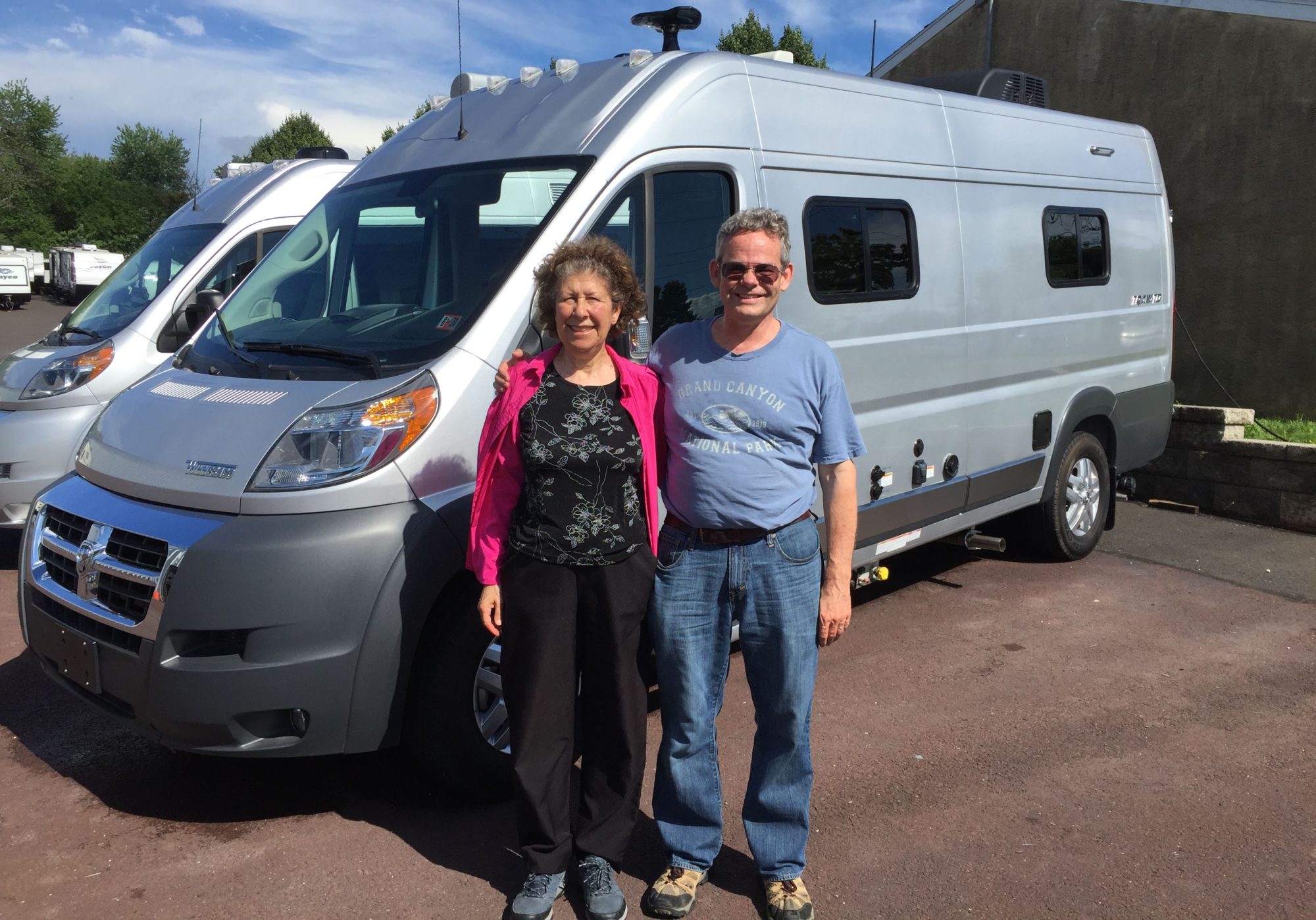March 23: (Caesar Creek State Park) We are now trying to drive 3 hours on each driving day so that we get to State College for the first week in April, but still have time to sightsee whenever we stop.
Our route took us through Lexington KY and Cincinnati, but we have decided that on the whole RVing is not a suitable way to see big cities – too much commuting. So, we proceeded north to Caesar Creek State Park.
This is a whole new camping experience, as the water in the park has been shut off for the winter. We have electricity and a sewer connection, but we have to rely on water we brought with us from Corbin, with no easy way to refill. When we started the trip, we did not have water in the RV, but the campgrounds had working bathrooms, showers and water taps. Now we have water in the RV, but if we run out, we will need to move on. We are using paper plates and bowls. We will not be showering for a couple of days.
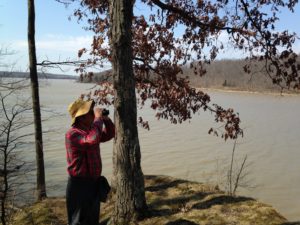 Not surprisingly, the campground is very empty with only a few other campers. It has filled slightly as the weekend arrived, mostly with campers from Dayton and Columbus, which are nearby. The weather is great, and the bugs are not biting.
Not surprisingly, the campground is very empty with only a few other campers. It has filled slightly as the weekend arrived, mostly with campers from Dayton and Columbus, which are nearby. The weather is great, and the bugs are not biting.
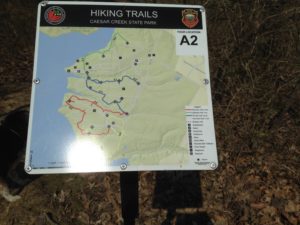 The park has a number of hiking trails, the most accessible of which is a series of loops connecting the 6 campgrounds with the lake. We walked all of them, while looking for birds. Most of the shoreline is a cliff down to the lake. However, with a strong wind whipping up the water from the bottom, the lake looks brown and dingy – not really that scenic. With few people in the park, Rumple can enjoy some off-leash time, which make the walk more pleasant for all of us.
The park has a number of hiking trails, the most accessible of which is a series of loops connecting the 6 campgrounds with the lake. We walked all of them, while looking for birds. Most of the shoreline is a cliff down to the lake. However, with a strong wind whipping up the water from the bottom, the lake looks brown and dingy – not really that scenic. With few people in the park, Rumple can enjoy some off-leash time, which make the walk more pleasant for all of us.
Our friend Phil let us know that Dayton was the home of the Wright Brothers and the Air Force Museum at the Wright-Patterson airforce base, so we decided to commute into town for the day. The men of the Paulson family have a deep connection with airplanes. In an odd coincidence, the family home was purchased from the son of a mechanic who worked with the Wright Brothers (George Pratt) and Chuck’s father compiled a lot of notes and also built and flew a plane to Mr. Pratt’s specifications.
Dayton was the Wright family home town. Kitty Hawk, on the Outer Banks of North Carolina, which we visited in 2012 just before Hurricane Sandy, was the test site for their prototype airplanes, and therefore the site of the historic first flight. However, all of the early developments leading to the test flights and the later developments leading to the patents and the commercialization of the planes were done in Dayton.
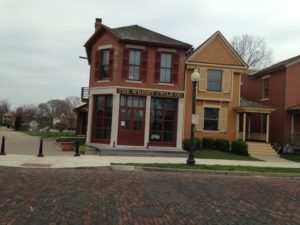 The museum starts in the Wright Brother bicycle shop. We did not realize that the Wright Brothers started as printers, and later got into bicycle sales and repairs. Most of their income came from sales of bicycles made by others. However, they did build custom bicycles.
The museum starts in the Wright Brother bicycle shop. We did not realize that the Wright Brothers started as printers, and later got into bicycle sales and repairs. Most of their income came from sales of bicycles made by others. However, they did build custom bicycles.
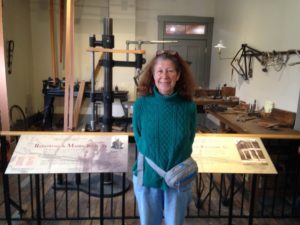 Our brother-in-law Richard Sachs builds custom bicycles and we were impressed at how similar the old workshop was to Richie’s modern shop. By the time they started building bicycles, the original “penny-farthing” bicycle with the tiny back wheel and huge front wheel was being replaced by the “safety bicycle” which looks like a modern bicycle and has a gear system.
Our brother-in-law Richard Sachs builds custom bicycles and we were impressed at how similar the old workshop was to Richie’s modern shop. By the time they started building bicycles, the original “penny-farthing” bicycle with the tiny back wheel and huge front wheel was being replaced by the “safety bicycle” which looks like a modern bicycle and has a gear system.
 The museum also had an old general store of the era.
The museum also had an old general store of the era.
The remainder of the museum has several parts including full-size models of the planes, an explanation of how their wind tunnel experiments led them to rework the tables of lift that others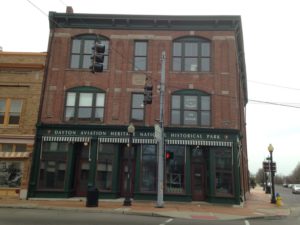 were using, and how the series of prototypes led to more designs that were more readily controlled. As well, the role of their mechanic, Charles Taylor, in developing a light weight engine was emphasized. However, there was no mention of Mr. Pratt, who claimed to have developed the wind tunnel for which the Wrights took credit. (Here are 2 articles on this – the first is by Chuck’s father: http://www.456fis.org/GEORGE%20_A._SPRATT.htm http://truthinaviationhistory.blogspot.com/2014/07/dr-george-spratt-letter-and-lost-friend.html). The museum also went through some of the Wright family history.
were using, and how the series of prototypes led to more designs that were more readily controlled. As well, the role of their mechanic, Charles Taylor, in developing a light weight engine was emphasized. However, there was no mention of Mr. Pratt, who claimed to have developed the wind tunnel for which the Wrights took credit. (Here are 2 articles on this – the first is by Chuck’s father: http://www.456fis.org/GEORGE%20_A._SPRATT.htm http://truthinaviationhistory.blogspot.com/2014/07/dr-george-spratt-letter-and-lost-friend.html). The museum also went through some of the Wright family history.
Interestingly enough, the US military and several other countries turned down the opportunity to invest in the planes.
A wing of the museum was devoted to parachute design, and this was also very interesting. I did not realize that early parachutes were designed for jumps from balloons and that the parachute was deployed by a catch on the basket. This type of deployment from the early airplanes led to parachutes entangled in the plane (and needless to say these accidents did not end well for the parachutist). The free-fall parachute was a very controversial idea – the parachutist jumps and is in free-fall until (s)he is sufficiently far from the airplane, at which time an auxiliary chute deploys and pulls the main chute out of a backpack. If the auxiliary chute does not deploy, the parachutist pulls a ripcord. Incidentally, “she” is not a post-feminist addition – while some of the early balloon parachutists were women, so was one of the early airplane pioneers, Georgina Ann “Tiny” Thompson, who started her skydiving career in 1913.
Another piece of the museum is devoted to African-American poet and author Paul Lawrence Dunbar, who was a high school friend of Orville Wright. He wrote some amazing poems. In fact, he has a huge body of work especially considering that he died at age 33. I am starting to read some of his poetry.
From the Wright Brothers Museum we went to the Air Force Museum, which is in 4 huge hangars near the field which the Wrights used to develop their more practical planes. It would take at least several days to properly see this museum. I stuck to the first hangar, which started from the Wright brothers and ended with WWII (although I did not get that far). Chuck worked his way through the WWI material and then headed to the last hangar to see the presidential airplanes which are on display there.
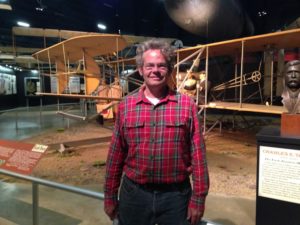 The first hangar continued the story of the Wright brothers and their competitors, through the development of the airplane industry as part of the war effort. (Remember this is a museum of the air force, not the airplane.) The first deployment of airplanes was for surveillance. It was not until later in the war that the planes were used to drop bombs and for aerial warfare.
The first hangar continued the story of the Wright brothers and their competitors, through the development of the airplane industry as part of the war effort. (Remember this is a museum of the air force, not the airplane.) The first deployment of airplanes was for surveillance. It was not until later in the war that the planes were used to drop bombs and for aerial warfare.
The US did not enter the war until 1917. There was then a very rapid move to train pilots, engineers and mechanics. Due to a shortage of fighter planes, only preliminary training was done in the US. Pilots were sent to Canada, Britain and France to complete their training.
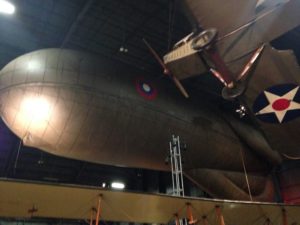 Like other aviation museums I have visited, this museum had a nice collection of vintage airplanes. There were also a couple of very unique exhibits. The museum had a WWI dirigible hanging from the ceiling. To give you and idea of the scale of the museum – it is “tucked” into a small corner. There was also a drone — the Kettering Aerial Torpedo “Bug” which essentially is a bomb with wings (and no pilot). As always in these exhibits, I cannot help but think that if the money and ingenuity that we expand on killing one another were instead spent on improving human life, we would be living in paradise.
Like other aviation museums I have visited, this museum had a nice collection of vintage airplanes. There were also a couple of very unique exhibits. The museum had a WWI dirigible hanging from the ceiling. To give you and idea of the scale of the museum – it is “tucked” into a small corner. There was also a drone — the Kettering Aerial Torpedo “Bug” which essentially is a bomb with wings (and no pilot). As always in these exhibits, I cannot help but think that if the money and ingenuity that we expand on killing one another were instead spent on improving human life, we would be living in paradise.
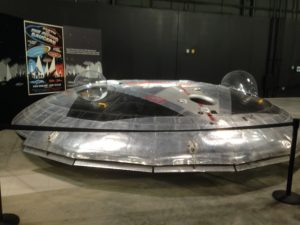 Chuck headed out to the last hangar, which had presidential airplanes and modern aircraft.
Chuck headed out to the last hangar, which had presidential airplanes and modern aircraft.
Chuck here – I found a flying saucer developed by the Canadian Air Force which sadly could not fly more than 5-6 feet high due to stability problems. It looks very cool though.
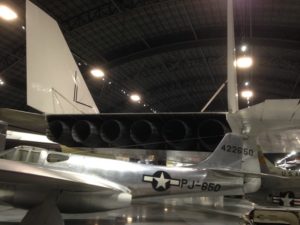 I don’t remember the name of this plane in the next picture, but the 6 rear engine exhausts looked so cool that I had to get a picture! It would be awesome to see the after burners lit on this plane.
I don’t remember the name of this plane in the next picture, but the 6 rear engine exhausts looked so cool that I had to get a picture! It would be awesome to see the after burners lit on this plane.
I also took a tour of the space shuttle with its cavernous cargo bay and tiny living quarters.
Finally I toured 3 of the early Air Force One planes. The first was used by FDR to fly to the Yalta conference, The office space was tiny, less than our RV dining room. The presidents office was a chair, a table, and a sofa with 2 seats. The last one was the plane used by JFK. It was a vast improvement with a fair amount of office space and an impressive communications center.
Altogether the museum was huge, we could have spent a week there and still not do it justice.
